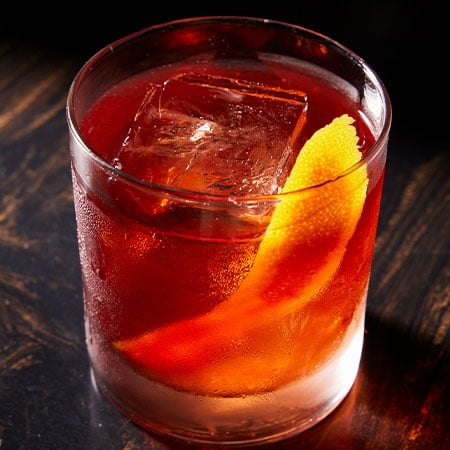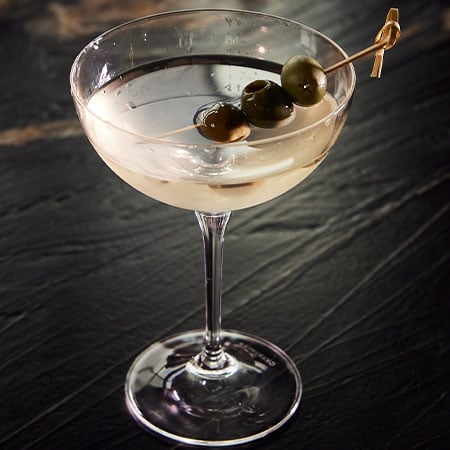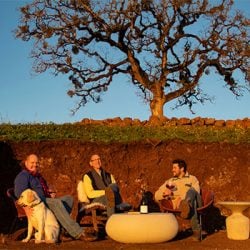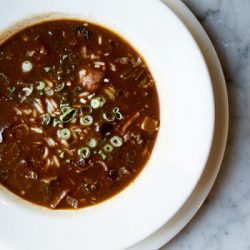The Oregon Distillers Guild Claims that the state has more distilleries per capita than any other in the US. California bests it by sheer volume—with 190 craft distilleries to Oregon’s 78—but, with one-tenth the population of California, Oregon has a lot of distillate to go around.
This hasn’t always been the case. In 1904, teetotalers rallied to make alcohol illegal in Oregon and the resulting Anderson Act of 1916 accomplished that task. Then the Volstead Act passed in 1919 and Prohibition swept the nation. After federal prohibition was repealed on December 5, 1933, the Oregon Liquor Control Commission formed four days later. Hood River Distillers was founded in 1934, making it the northwest’s oldest distillery.
The Oregon Distillery Trail, established in 2013, today links 54 distilleries from Warren in the north to Ashland in the south. And many of them specialize in craft-distilled gin. I recently assembled a panel of six mixologists and bartenders in Los Angeles to taste 30 of them. The results surprised us, as the quality and complex flavor profiles rivaled those of many more established brands. Evan McCarthy of Golden Gopher went so far as to say, “These are the best gins I’ve ever had.”
The various styles ranged from traditional London Dry to pinot barrel–aged. What intrigued us was how each style lent itself to different cocktails. While some gins shone as sippers—like Pilot House Distilling’s Painted Lady Barrel Aged Gin—others weren’t strong on their own yet sang when mixed into a cocktail. The sweet coconut flavors of New Deal’s Old Tom Gin reminded us of rum and tiki cocktails, and when mixed into a Gimlet it was terrific—a great Daiquiri alternative. It reminded me that some of my favorite wines aren’t meant to be enjoyed on their own but meld beautifully with certain food pairings; likewise, some spirits are straight pleasure-sippers and some play best with others. Here’s our pilgrimage along the Oregon Gin Trail, distilled from north to south, with highlights of the best gins we tasted and the cocktails they inspired.


A LAST WORD IN ASTORIA
Painted Lady New American Gin (Pilot House Distilling)
Painted Lady launched in 2013, the same year Pilot House got its start. This complex gin is citrusy and woodsy on the nose, leading with spice and herbs—sage, rosemary, coriander and a cinnamon note, vaguely reminiscent of Red Hots. The citrus scents are exotic—more Buddha’s hand than Meyer lemon—and while the mouthfeel is lush and round, it doesn’t feel weighty, with pink peppercorn and chamomile lingering on the finish. For Rich Williams from Otium, “Every-thing is turned up to a ten.” This was a gin that fascinated our panelists. “I’d pull this out for someone who drinks gin all the time and wanted to try something new and exciting,” said 71Above’s Rebecca Marie. And Death & Co.’s Joe Rinaldi recommends mixing it into an herbal cocktail, like a classic Last Word with green Chartreuse.
A VESPER MARTINI IN FOREST GROVE
Union Gin (Dogwood Distilling)
This London Dry style is bright, fresh and floral with interesting spearmint and lavender notes. This is a clean gin—“It isn’t embarrassed naked,” laughed Williams. James Garay of 71Above agreed, “I could drink this one straight.” And while some of the others in the lineup may have had more unusual flavor characteristics, Golden Gopher’s Evan McCarthy wasn’t sure that was always helpful in mixing. “Some gins bring a lot of white noise to cocktails,” he said. “This one plays well with everyone.” Which was why we thought it was a good choice for a sometimes difficult-to-get-right cocktail: the Vesper. The mix of two ounces gin, one-half ounce vodka and one-quarter ounce Lillet Blanc results in a cocktail without sweetness or citrus to soften the spirits. Union Gin was up to the task; its clean citrus character carried over, enhanced and rounded out by the florals from the Lillet.
AN EARL GREY TEA COCKTAIL IN PORTLAND
Freeland Spirits Gin
Founded by Jill Kuehler and named after her Grandma Freeland—who inspired her to create a woman-owned distillery—this gin is herbaceous and woodsy with wet-stone minerality and delicate florals. “It’s more men’s cologne than garden flowers,” Belinda Acevedo of 71Above found. Garay said it reminded him “of digging fresh earth in a garden.” And while the herbaceous notes of sage, pine needle and licorice lead, sweet lemon peel rushes in on the finish. Acevedo loved it mixed with Fever Tree Elderflower Tonic. Garay thought it would be great with Earl Grey tea or bergamot liqueur. When mixed into a Gin and Tea, the florals from the gin balanced well with the bergamot; the lemon and honey syrup enhanced the gin’s herbal tones.


A BEE’S KNEES IN PORTLAND
Aria Portland Dry Gin
Distillers Ryan Csansky and Erik Martin created this gin with versatility in mind, naming it Portland Dry. It’s true to the classic London Dry style leading with juniper, coriander and lemon peel. There’s an earthy, tree-bark quality—cassia is one of its ten botanicals—with a lush, silky finish. This gin is smooth, with a fresh minerality, clean enough to be enjoyed over ice, or a in a cucumber spritz. It’s also perfect for a classic Bee’s Knees: The savory bark-and-root quality played well with the honey syrup in the cocktail, while fresh lemon juice managed to coax out even more orange-peel citrus and cardamom spice on the finish.
AN EASTSIDE IN PORTLAND
Aimsir Distilling Co. Aitil House Gin
Husband-and-wife team Steve and Christine Hopkins established Aimsir Distilling Company in 2016. Their savory Aitil House Gin is vegetal and herbal: It begins with lemon and lavender and ends with spearmint, thyme and star anise. Our first thought was to use it in a twist on the Last Word. Williams recommended one ounce gin, one-half ounce maraschino liqueur, and three-quarter ounces each of yellow Chartreuse and lime juice. The cocktail was delicious—we kept going back sip after sip—but it seemed that the chartreuse melded so seamlessly with the Aimsir that it masked its unique vegetal notes. So, we tried mixing it into a classic Eastside, and the gin found its voice. The lime, mint and cucumber served as back-up to the stronger licorice and herbal notes, supporting rather than overpowering. To enhance the gin’s flavor even more, dilute the lime and simple syrup with a couple splashes of club soda.
A CLASSIC DIRTY GIN MARTINI IN PORTLAND
New Deal Gin No. 1
When New Deal opened in 2004, it was one of the smallest licensed distilleries in America. Based in Portland, New Deal makes small-batch gin with Bull Run River water—a fresh-water tributary of Oregon’s Sandy River—and uses only locally sourced ingredients. When we first tasted New Deal’s Gin No. 1, we weren’t immediately sold. It wasn’t overly aromatic, and it was thicker and brinier than some of the more floral gins in the tasting. Acevedo called out “a marjoram-and-white-sage quality with woodsy herbs,” and her colleague Garay suggested it would be better for mixing than sipping on its own. The label describes the bottle as “a savory gin in the garden style,” providing its own New Deal Dirty Martini recipe on the back. So, we decided to try it: two-and-a-half ounces New Deal Gin No. 1, one-half ounce olive brine and one-quarter ounce dry vermouth (we used Carpano). They melded into a delicious and savory dirty gin Martini which caught my attention. I often don’t care for dirty gin Martinis when the florals over-power the saltiness of the olive juice but, in this case, the gin’s lack of floral aromas allowed the drink’s brininess to bring out the vermouth’s aromatics, which, in turn, heightened the gin’s flavors, revealing lemon and orange citrus components.


A BARREL AGED GIN & TONIC IN OREGON CITY
Trillium Pink Pinot Gin (Trail Distilling Company)
Oregon City was the last stop on the historical Oregon Trail. Here, Trillium produces Pink Pinot as its flagship gin. Aged in Oregon pinot noir barrels for a minimum of two months, the gin has a pink-amber color and a salty-fresh scent. Just-popped kettle corn jumped out along with savory caramel, but red berries and floral notes persisted underneath. There’s a woodsy, umami character that stokes the appetite. It reminded Acevedo of caramelized carrots; for Garay, it brought to mind peach pie with cacao. Williams questioned the oak. “I’m trying to get over my own bias that gin shouldn’t be brown,” he stated. But McCarthy argued, “Why is there a rule to barrel-aging? Why can’t you play and round it out?” And, while there was some debate about whether we’d want to sip this gin straight, everyone agreed it made the perfect G & T. Williams said, “The tonic brings out its citrus notes.” And McCarthy—who claims generally not to like tonic—loved how the caramel blended with the sweet and bitter tonic flavors.
A GIN FIZZ IN NEWBERG
Ewing Young Distillery Miranda’s Oregon Summer Dry Gin
Named after the pioneer who established Oregon’s westernmost farm in Chehalem Valley in 1834 as well as the first distillery in Oregon County, this present-day distillery lies on the same land, 125 yards from Young’s gravesite. This gin is named for Miranda, his best friend’s wife, who planted an acorn at his burial site, which is now the Ewing Young Oak, an Oregon Heritage tree. Miranda’s Oregon Summer is made with local botanicals; it feels sunny, with bright scents of citrus, crisp cucumber and a hint of salty ocean air from the nearby Pacific. There are fresh and dried floral notes with cracked pepper and elderflower lingering on the finish. Mixed with grapefruit juice, sparkling water and Prosecco, this could make a great alternative to an Aperol Spritz. We mixed it into a classic Gin Fizz. The citrus and cucumber notes were enhanced by the lemon juice and club soda, and the egg white gave the drink a fluffy, creamy body, perfect for sipping on the porch on a hot summer night.
A FRENCH 75 IN NEWPORT
Rogue Farmhouse Gin
Rogue started as a brewpub, founded by Jack Joyce in Newport, Oregon in 1988, later expanding into a distillery in 2003. This cucumber-forward gin boasts 100 pounds of fresh cucumber per batch but it’s not a one-note spirit. Fresh lemon, lime and bergamot on the nose mix with juniper, thyme and basil on the palate, followed by an interesting pop of red berry and litchi on the finish. With its smooth, silky mouthfeel, this could be a great starter for non-gin drinkers: “This is the gin that doesn’t offend anyone at the party,” said Marie. Rinaldi suggested the pure quality would make a great dry gin Martini or a spring sipper with soda and basil. It was also perfect in a French 75. The citrus in the drink played well with the citrus notes in the gin and the bubbles seemed to match the gin’s lively energy.


A LAVENDER GIN & TONIC IN EUGENE
Thinking Tree Spirits Gifted Gin
At Thinking Tree, head distiller Kaylon McAlister uses handmade stills, filtering his spirits more than 21 times to ensure their purity. This gin is bright and full of orange-zest scents. On the palate, the gin grows more complex with floral notes of lavender and rosewater before finishing with savory rhubarb. The body feels powdery and lush, the little bit of sweetness clamoring for something bitter. Rinaldi suggested a negroni could work but Marie said the gin’s citrus called for something spritzy. We tried it in a classic Gin and Tonic—and found that the bitterness from the tonic balanced the sweetness from the orange peel and coaxed out vegetal notes like fresh-cut celery. When we stirred in a little Monin Lavender syrup and topped with a rosemary sprig, all the flavors fused seamlessly. The lavender helped to accentuate the floral notes of the gin while maintaining the orange-peel finish.
AN AVIATION IN EUGENE
Elk Rider Gin (Heritage Distilling Co.)
Named after Heritage Distilling Company’s 19th-century pioneer founders—famous for domesticating and riding local elk—this gin leads with aromas of pine needles, spruce trees and pink peppercorns. It feels wintergreen-minty on the palate, lightly grassy with a touch of fresh-squeezed lemon. Acevedo said it reminded her of Christmas-tree bark—we thought it would be great mixed with mulled-wine syrup or Sorel liqueur. Garay suggested using it in a Rob Roy or mixing into an Aperol Spritz. It also complemented the floral notes in an Aviation cocktail.
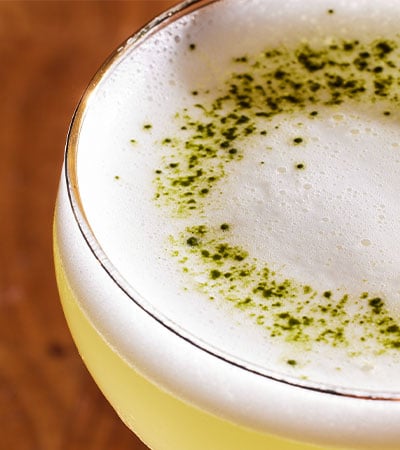

A NEGRONI IN BEND
Crater Lake Prohibition Gin
Created in 1996 by Jim Bendis and distilled by Bob Monroe, this modern interpretation of Prohibition-style or “bathtub” gin is cool and sophisticated. It doesn’t need to show off, confident in its pure juniper flavors with hints of lilac and lemon, derived by infusion of the botanicals into the neutral base spirit. It’s savory, round and velvety on the tongue. And while it could be great in a Martini with a twist of lemon, it shone in a classic Negroni. The weight of its mouthfeel stood up to the herbal sweet vermouth flavors of Carpano Antica Formula, and its hint of cedar rounded out Campari’s bitterness, coming through almost caramel-like.
The quality of Oregon’s gin left me with one question: the state has already been recognized for its terroir when it comes to wine, but is there also terroir expression in Oregon’s gin? New Deal attributes some of its success to the local water from Bull Run River. Thinking Tree uses locally sourced lavender for its florals, while Aria utilizes Oregon Angelica Root for its spice. Situated on Oregon’s coastline off Yaquina Bay—where air flows in off the Pacific Ocean—Rogue’s Farmhouse Gin carries the energy of a fresh sea-breeze. Or is it the distillers themselves? Four of the featured distilleries are in Portland, on either side of the Willamette River—where the city’s movement to “Keep Portland Weird” breeds inventive minds. With so many quality gins, it’s hard to ignore that this region is establishing itself as a place for more than grape-growing. And while terroir expression continues to elude the constraints of science, our panels relied on taste. And, simply put, these gins taste good.
Based in Los Angeles, California, Alissa Bica is the Associate Editor and Spirits Critic at Wine & Spirits. She is also a sommelier at 71 Above and co-runs the home wine tasting company, Côte Brune and Blonde. In any rare moments of free time, she writes about obscure grape varieties in the blog Off the Beaten Wine Path.
This story appears in the print issue of Spring 2023.
Like what you read? Subscribe today.

